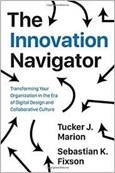- Innovation
The Innovation Navigator
How to leverage digital design and collaborative culture to steer through the ever-expanding innovation landscape
In a business environment characterised by rapid technology driven change innovation is more essential than ever. Maintaining competitive advantage and achieving sustainable growth can depend on it – whether through radical inventions and breakthrough business models or by incremental improvements to business practice.

Advances in technology, which have exacerbated the need, have also been helpful in providing new ways for businesses to innovate. What Tucker Marion of Northeastern University and Sebastian Fixson of Babson College call the ‘innovation landscape’, in their new book, is now larger and more diverse than ever before, caused, by a ‘perfect storm’ generated by the convergence of digital design, social networking and collaborative culture. This expanded landscape offers many new opportunities for innovation, but it is a difficult landscape to navigate.
…………………………………………………………………………………………………
Dates: April 29–May 3, 2019│ Format: In-class study │ Location: Toronto
……………………………………………………………………………………………………
While innovation is recognised as a crucial need it often faces barriers such as lack of project ownership, risk avoidance, failure to prioritise over the status quo, inadequate funding, and crucially the fact that the need for innovation is often ill-defined in terms of goals and actions.
In the Innovation Navigator, Marion and Fixson provide an accessible guide to defining goals and actions and a framework for leveraging digitized design and new collaborative approaches to drive innovation.
Understanding the two forces of digitized design and collaborative culture is central to the authors’ methodology.
Digitized design is about how over the past few years exponential growth in computer power has enabled the development of more sophisticated tools for designers and how digitization, by switching the emphasis in design processes from expert humans to expert machines, has enabled many more less expert people to participate in innovation.
Collaborative culture is a social phenomenon spawned by social media and the millennial generation that grew up as digital natives, accustomed to sharing and collaborating. In this era of Airbnb and the open source software community, people often collaborate without traditional hierarchical controls or even without the exchange of money.
Using numerous real-world examples to illustrate their methodology, the authors investigate these four innovation archetypes or modes which feature prominently in the expanding innovation landscape:
Specialists – Organizations with specialized expertise in their industry sector employ technologies to achieve entirely new solutions and superior product performance.
Venture – New corporate ventures lower the barriers for employees to self-select into entrepreneurial projects, while reducing the constraints of bureaucracy.
Community – The community brings new sources of knowledge by expanding past the company's boundaries, dramatically increasing the number of participants.
Network – The network creates partnerships and ecosystems that create innovations that could not be developed by individual companies alone.
The simple goal of the for-profit company is to innovate new products and services that increase revenue and profitability, drive growth and distinguish its offerings from the competition. Unfortunately, the failure rate for new innovations is regularly reported to be around a persistent 40%.
By understanding Marion and Fixson’s four modes and using them sometimes in combination, and by leveraging digitized design and collaborative tools, organizations can navigate the innovation landscape more effectively and steer well clear of the 40%.
‘The Innovation Navigator: Transforming Your Organization in the Era of Digital Design and Collaborative Culture’.
By Tucker J. Marion and Sebastian K. Fixson. Published by University of Toronto Press, 2018, ISBN 978-1-4875-0111-2
Rotman School of Management is Canada’s leading business school and has Canada’s largest group of management faculty. It is home to some of the most innovative research institutes in the world
ARTICLES YOU MIGHT LIKE
VIEWPOINT
Cognitive neuroscientist, Lynda Shaw, explains how to understand and support intrapreneurs
DEVELOPING LEADERS QUARTERLY MAGAZINE AND WEEKLY BRIEFING EMAILS


































